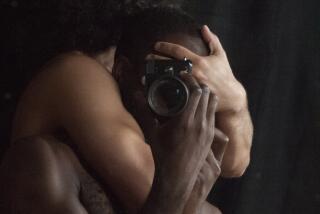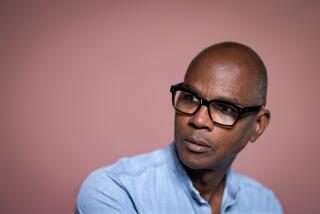We can’t stop talking about the Donelle Woolford controversy
Who is Donelle Woolford? Who is Joe Scanlan? It’s a debate that keeps going and going.
A couple of weeks ago, I wrote a pretty epic (as in: loooong) overview and analysis of the controversy surrounding Woolford, the fictional African American female artist conceived by artist Scanlan, who is white.
The short version of the story is this: Late last year, Woolford was listed as an artist in the prestigious 2014 Whitney Biennial. Since then, the inclusion of a fictional black artist in an exhibition that featured only eight “real” black artists has drawn continual criticism from bloggers, critics and other artists — with attacks on Scanlan’s motivations to problems of diversity at the Biennial. (For the long version of the story, see my piece from June.)
The discussion over Woolford continues to simmer online and other stories on the subject have been published since my story ran. The most sensational of these has been Ryan Wong’s “I Am Joe Scanlan,” which appeared on the arts site Hyperallergic in mid-June. In the essay, which was a parody, Wong claimed that Scanlan was a character that he had created, in the manner that Scanlan created Woolford. Even though it was satire, a lot of readers mistook it as real.
Wong’s article also included a photograph of Scanlan from a work titled “Pay Dirt” that shows the artist with mud on his face. In light of the controversy surrounding the Woolford debate, this photograph has been held up as evidence of blackface.
I haven’t seen any evidence that it is — and neither for that matter has artist and critic Coco Fusco, who mentions it in her essay in the Brooklyn Rail. The picture is tied to a conceptual piece about dirt — yes, dirt — that Scanlan did in 2003. Scanlan showed me images of the photograph in context and I get the sense that the image was truly about dirt (and manufacture and commodification and ... you get the picture).
An excellent piece about Wong’s satire and the discussion that emerged out of it is nicely summarized in a story by Nathan Pensky for the Daily Dot. It features fresh interviews with both Scanlan and Wong and is more than worth a read.
But the matter that has interested me most in all of this has been the discussion about the nature of the collaboration between Scanlan and the actors he works with. (This was something I discussed at some length in the second half of my original essay.)
Throughout all of this, it has been Scanlan who is most often attributed as the artist and it is Scanlan who is routinely quoted defending the work. In a tweet from June 20, Hyperallergic writer Jillian Steinhauer raises the fair question of why this is the case: “Scanlan claims he, Kidwell, Ramsay are now collaborators on Donelle Woolford,” she asked. “But why is he still listed as author?”
The issue of credit and collaboration is one of the trickier aspects of the Donelle Woolford piece, since it is Woolford who is generally listed as the artist — and not anyone else. (The Whitney Biennial catalog and the press announcement for the exhibition, for example, both listed Woolford alone.)
During interviews I conducted with Scanlan back in early June, he said this was intentional. “We like to maintain the idea of Donelle Woolford as a fiction in every direction possible,” he explained via email. “We want to establish her as a mythic character without our names getting in the way.”
The Whitney Biennial and its attendant rain of press has pretty much nuked the possibility of maintaining too much mystery. It has also exacerbated the question of credit and, to some degree, how collaborative the piece truly is.
As I noted in my original story, both Scanlan and Jenn Kidwell have said that the piece and their collaboration has evolved over time. But there are still questions over how much voice a performer like Kidwell has in the work.
When I interviewed Kidwell last month, she expressed frustration over how her contributions had been overlooked by critics and the public in the debate surrounding the piece.
“I’ve felt un-addressed,” she told me. “There is a black artist present in this piece. Why am I erased from it? Why do I continue to be erased from it?”
With the debate about the issue of credit and collaboration somewhat renewed, I contacted her again to see what she had to say about it.
“In any collaboration, there is more credence given to the person who originated the piece,” she replied via email. “Donelle Woolford is no different. While we work together, we stick to our interests. That said, I dictate the pitch of my participation, which explains why Joe is more ‘out there’ than I am. The terms of a collaboration are negotiated by the collaborators, not the limelight or the public.”
Scanlan, in a follow-up email discussion conducted this week, echoed the sentiment: “It really seems like a question for the questioners,” he adds, “why they can’t accept something that’s been confirmed by all persons involved?”
“People assume I’m the go-to guy and either don’t know or aren’t interested in how [the piece] has evolved over time,” he adds.
Which all goes back to how we as an audience have reacted to the work, and the assumptions we make about who is and isn’t in charge in a scenario involving a white man and an African American woman.
Interestingly, Scanlan told me that he has offered his collaborators’ contact information to several members of the media, who have chosen to focus the story purely on him.
And I think that’s where the problem lies. This isn’t simply about Joe Scanlan — or Jenn Kidwell or Abigail Ramsay. We can deconstruct Scanlan’s motivations and the relationship he maintains with his collaborators until the next Biennial and not move a step forward. We can debate whether it is or isn’t a good piece of art. We can pick apart some callous-sounding thing Scanlan said on Facebook six months ago. I think that misses the point.
To me, the debate that surrounds the Donelle Woolford piece is about something much bigger. It’s about who the institutions of culture currently imbue with the authority to make and show art. And whether we choose to accept it.
More to Read
The biggest entertainment stories
Get our big stories about Hollywood, film, television, music, arts, culture and more right in your inbox as soon as they publish.
You may occasionally receive promotional content from the Los Angeles Times.











